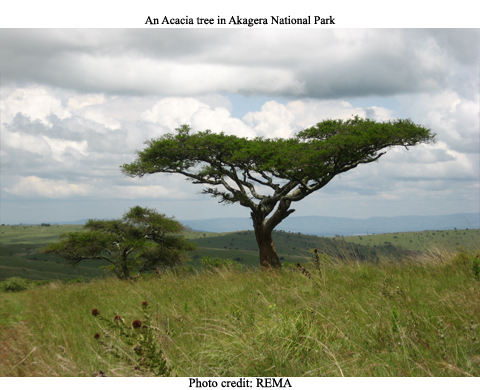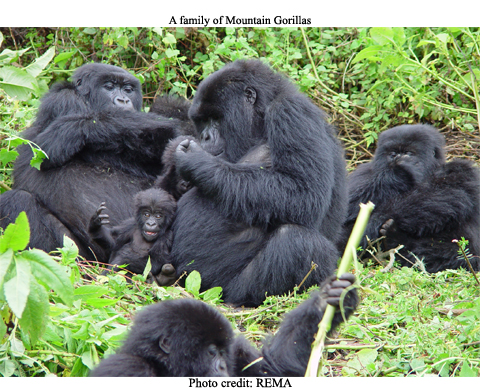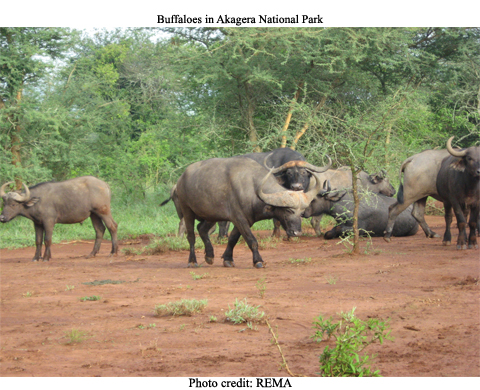Biodiversity can be defined as the variability of life expressed at the ecosystem, species and genetic levels. It provides a large number of goods and services that sustain our lives. Biodiversity is the combination of life forms and their interactions with each other and with the rest of the environment that has made the earth a uniquely habitable place for humans (SCBD 2000). The biodiversity we see today is the fruit of billions of years of evolution, shaped by natural processes and, increasingly, by the influence of humans.
Although Rwanda is a small country, it has a remarkable variety of ecosystems and of flora and fauna. Its location at the heart of the Albertine Rift eco-region in the western arm of the Africa’s Rift Valley is a contributory factor. This region is one of Africa’s most biologically diverse regions. It is home to some 40 per cent of the continent’s mammal species (402 species), a huge diversity of birds (1,061 species), reptiles and amphibians (293 species), and higher plants (5,793 species) (Chemonics International Inc. 2003, MINITERE 2005).
Ecosystem and habitats
The Albertine Rift is considered to have the highest species richness in Africa. It is considered a biodiversity hotspot containing more endemic mammals, birds, butterflies, fish and amphibians than anywhere else in Africa. Habitats supporting such an array of biodiversity are very varied. Being at the heart of the Albertine Rift, Rwanda’s habitats are equally varied, ranging from afro-montane ecosystems in the northern and western regions to lowland forests, savannah woodlands and savannah grasslands in the southern and eastern regions. There are other habitats around volcanic hot springs and old lava flows, especially in the northern and western part of the country. Rwanda also has several lakes and wetlands which are rich in different species. Though not yet well surveyed, all these ecosystems host a rich variety of fauna and flora and micro-organisms.
Besides these natural ecosystems, as an agrarian country, Rwanda agro-ecosystems comprise cultivated land, agro-pastoral areas, grassland, grazing and fallow land (MINITERE 2003a).
Species Diversity
Flora: Rwanda harbours very diverse flora due to a considerable geo-diversity and a climatic gradient from west to east. The number of vascular plants is estimated at around 3000 species originating from the different bio-geographical regions (Fischer and Killmann 2008).
Rwanda constitutes the eastern limit for plants from the Guineo-Congolian region. An example of these plants is the Thonningia sanguinea (Balanophoraceae), widespread in Western and Central Africa. It is only found in the Cyamudongo forest in western Rwanda. Plants from the afromontane region are confined to higher altitudes, such as the orchid Disi robusta found in Nyungwe forest. The Eastern African savannah elements comprise the Zambezi floral region, and most these plants are found in the Akagera National Park and its surroundings (Fischer and Killmann 2008).
About 280 species of flowering plants from Rwanda are considered to be endemic to the Albertine Rift. Of these endemic species, about 20 are restricted to Rwanda, 50 species confined to Rwanda and Eastern Congo and 20 species found only in Rwanda and Burundi. Twenty one species are found additionally in the forests of western Uganda, eastern Congo, Rwanda and Burundi. Examples of these distribution types are Impatiens bequaertii (Balsaminacea), Impatiens mildbraedii (Balsaminacea), Monathotaxis orophila (Annonaceaa) or Liparis harketii (Orchidaceae) (Fischer and Killmann 2008).
Rwanda has 56 local endemic flowering plants, out of which 47 are confined to Nyungwe National Park (including Cyamudongo forest). Examples of these plants are the recently discovered species Impatiens nyungwensis Eb.Fisch., Detchuvi & Ntaganda, (Balsaminaceae) Afromomum wuertii Dhetchuvi & Eb. Fisc (Zingiberaceas), Diaphananthe delepierreana Lebel & Geerinck (Orchidaceae) and Ypsilopus liae Delpierre and Lebel (Orchidaceae) all endemic to Nyungwe National Park (Fischer and Killmann 2008). The number of these newly discovered species shows that the number of plant species found in Rwanda is far from being totally known.
The afro-montane ecosystems comprised of the Volcanoes and Nyungwe National Parks, Gishwati and Mukura Natural Forests, and other small forests found at the Congo-Nile Ridge, is varied and rich in plant species.
The biodiversity in the lowlands of the eastern part of Rwanda comprises mainly savannah with grasses, bushes and trees, mountain rainforests in the Akagera National Park and gallery forests in the eastern part of Rwanda. Gallery forest around lakes and other water bodies are mainly found in the Akagera complex, where they cover almost 163 hectares (Twarabamenye and Gapusi 2000 in MINITERE 2003a). The flora of these forests comprise 66 species including Acacia kirkii, Acaccia polycantha, Acacia sieberana, Albizia gummifera, Cordia Africana, Crotonmacrostachis, Dombeya burgessia, Dombeta kirkii, Erythria absysniica, Newtonia buchananii and Techlea nobilis. There are also some rare or threatened species such as Impantiens irvingii, Markhamia lutea, Eulophia guineensis and Pterygota mildbraedii, considered a fossil plant (MINAGRI 1998).

Most of the plant species found in these forests are used in traditional medicine and some plants reveal important biochemical extracts. This is the case with Blighia unijugata, Grewia forbesi, Rhus vulgaris, Pterygota mildbraedii and Ficus species (MINITERE 2003a).
With more than 104 flower species, wetlands and aquatic ecosystems are also rich in biodiversity. Some lakes such as Kivu, Bulera and Ruhondo are poor in macrophytes (MINITERE 2003a). About 50 species of plankton are found in these ecosystems distributed in the following families: Chlorophyceae, Cynaphyceae, Pyraphytes, Bacillariophyceae, Cynophyceae, Pyrophytes, Euglenophyceae, and Diatomophyceae. There are reports of colonization of Nymphea nouchalii and Nymphea lotus in the lakes of the eastern region. The Water hyacinth (Eicchornia crassipes) presents a big threat to the biodiversity of these lakes. The flora is dominated by Cyperus papyrus. Some of these lakes are associated with gallery forests with the dominating species being those of the genus’ Phoenix, Bridelia, Ficus, Aeschynomene and Echinochloa. Ferns are also found and in some places there are Echinochloa pyaramidalis.
The agro-ecosystems have food crops species like Sorghum, Phaseolus vulgaris, Eulisine corocan, Colocasia antigonum, Zea mays, Oryza sativa, Triticum sp., Hordeum vulgare, Pisum sativum, Soja hispada, Arachis hypogea, Ipomea durcis, Irish potatoes, Manihot esculenta and the banana (Musa). They are also commercial crops like coffee, tea and pyrethrum. The agricultural production systems also accommodate many related wild species, the most common being Eragrostis sp., Bidens pilosa, Digitaria sp., Conyza sumatrensis, Cyperus sp. There are also plant forage crops including Tripsacum laxum, Setaria sp, Desmodeum sp. Pennisetum purpureum, Mucuna pruriensis, Cajanus cajan Calliandra calothyris, Leucaena diverifolia, and Sesbania sesban (MINITERE 2003a).
Tree species found in Rwanda include Ficus thoningii, Euphorbia tirucalli, Erythrina abyssinica, Verminia amygdalena, Dracaena afromontana, among others. The first afforestation efforts took place between 1920 and 1948 during which time Eucalyptus was introduced. Other species introduced later included Pinus sp, Callistris sp, Grevillea robusta, Cedrella sp, and Cupressus. (MINITERE 2003a).
Fauna
Rwanda shelters 151 different types of mammal species, eleven of which are currently threatened and none of which are endemic. Among them are the primates (14 to 16), with half of the remaining world population of mountain gorillas (Gorilla gorilla berengei). The gorillas are found in the Volcanoes National Park. Others includes the owl-faced monkey (Cercopithecus hamlyni), the mountain monkey (Cercopithecus hoesti) in Nyungwe, the Chimpanzee (Pan troglodytes) in Nyungwe and Gishwati, and the Golden monkey (Cercopithecus mitis kandti) found in Volcanoes National Park. There are also 15 species of antelope, and a wide diversity of species such as buffalo, zebra, warthog, baboon, elephant, hippopotamus, crocodile, tortoise and rare species such as the giant pangolin (Chemonics International Inc. 2003, MINITERE 2005).

Rwanda is one of the top birding countries with 670 different birds having been recorded. Four of species of birds in Rwanda are threatened with extinction: the shoebill (Balaeniceps rex) found in Akagera; Grauer’s rush warbler (Bradyptrus graueri) found in Volcanoes National Park in Nyungwe and in the swamps of Rugezi; the Kungwe apalis (Apalis argentea) found in Nyungwe; and the African or Congo barn owl (Phodilus prigoginei) found along Lake Kivu (Chemonics International Inc. 2003).
Animal races bred in Rwanda are mixed with native and non-native races. These include cattle (Ankole, Sahiwal, Frison, Alps brown and the Australian Milk Zebu), goat (Alpine and Anglonubian), sheep (Karakul, Merinos and Dorper), pig (Large white and Landrace, Piétrain), poultry (Leghorn, Rhodes Island Red, Derco, Sykes and Anak), fish (Tilapia and Clarias) (MINITERE 2003 a).
Fish species found in aquatic ecosystems comprise Haplohcromis, Synodontis, Barbus, Labeo, Tilapiines, and Clarias species. Raimas moorei and Limnothrissa miodon were introduced into Lake Kivu at the end of the 1950s (MINITERE 2003a).
Conservation status of biodiversity
This rich biodiversity is mainly conserved in protected areas (three national parks, natural forests, wetlands). These cover almost 10 per cent of the national territory while the rest of the country is densely populated.
The Volcanoes National Park is home to about 30 per cent of the global population of Mountain Gorilla (Gorilla gorilla beringei). It has other 115 mammals’ species, including the golden monkey (Cercopithecus mitis kandti), elephants, buffaloes, 187 bird species, 27 species of reptiles and amphibians and 33 arthropod species. CITES consider Rana anolensis, Chameleo rudi and Leptosiaphos grauer endangered (MINAGRI 1998, Chemonics International Inc. 2003). It has also 245 plants, 17 of which are threatened; and 13 species of orchids including Disa starsii, Polystachya kermessia, Calanthes sylvatica, Chamaengis sarcophylla, Cyrtorchis arcuata, Habenaria praestans, Stolzia cupuligera, Eulophia horsfallii, among others (Chemonics International Inc. 2003).
Nyungwe National Park has 75 species of mammals, including 13 species of primates with some on the IUCN Red list such as the Eastern Chimpanzee (Pan troglodytes schweinfurthii), owl-faced guenons, (Cercopithecus hamlyni) and the Angolan Colobus monkey (Colobus angolensis ruwenzorii). The national park is also considered an African Important Bird Area (IBA) with 285 bird species comprising 25 endemic to the Albertine Rift (Plumptre et. al. 2002, Fischer and Killmann 2008). Of the 1,200 plant species inventoried in the Nyungwe National Park - 265 species were trees and shrubs and of these 24 are endemic to the Albertine Rift. Among the plant species in the park, 5 species of trees and 6 species of grass are endemic to the park. These include Oricia renieri, Pentadesma reyndersii, Pavetta troupinii, Psychotria palustris and Tarenna rwandensis. The flora of the park also comprises 148 species of orchids, of which 19 are endemic (MINITERE 2005). The following species of orchids found on the CITES list are also found in the park: Diaphananthe biloba, Disa eminii, Disperis kilimanjarica, Euggelingia ligulifolia, Eulophia horsfallii, Polystachya fabriana, Polystachya hastate and Tridactyle anthomaniaca (MINITERE 2005).
The wildlife in the Akagera National Park comprises 90 species of mammals, 530 bird species and 35 fish species. The most threatened species are rhinoceros, large carnivores, particularly lions. Many species in the Akagera National Park are protected by the CITES convention such as Loxodonta africana (African elephant), Sincerus caffer (buffalo), Panthera leo (leopard) and Tragelaphus spekii (sitatunga). (MINITERE 2003a, MINITERE 2005). The flora of the Akagera National Park is diverse and 6 species of orchids are recorded. The grass savanna is dominated by Themeda triandra and Hyparrhenia sp. accompanied with normal species like Sporobolus pyramidalis and Botriochloa insculpta. Acacias are the most trees found in the forest savannah, and the following species are recorded: Acacia senegal, A. Sieberiana, A. polyacantha campylacantha, A.gerardii and A. brevispica. Species of Combretum are also found in the park (MINITERE 2005).

Natural forests are rich in fauna species. Gishwati forest includes species such as Pan troglodytes schewinfurthii, Colobus angolensis ruwenzorii, Potamochoerus porcus, Cephalophus nigrifons, Dendrohyrax arboreus, Felis serval and Felis aurata (MINAGRI 2002 in Munanura et. al, 2006). The Tree squirrel (Funisciurus pyrrhopus), Rwenzori sun squirrel (Heliosciurus ruwenzori), Ground hog (Thryonomys swinderianus) and the jackal species (Canus spp.) are found in Mukura forest. Makura is also rich in birds with 59 species recorded, among them 7 Albertine Rift endemic species: Tauraco johnstoni, Apalis personata, Apalis Ruwenzori, Cynnyris regia, Zoothera tanganjicae, Bradypterus graueri and Parus fasciiventer (Munanura et. al. 2006).
Rugezi wetland is habitat to an endangered bird and hosts 60 per cent of the global population of Grauer’s swap-warbler (Bradypterus graueri). It is also habitat to 19 bird species, including two species of Threskiornithidae, protected by CITES. Apart from Clarias liocephalus and Haplochromis sp., the wetland is not rich in fish species. A low number of mammals are also identified: several species of Muridae, Tragelaphus spekei and Aonyx capensis. (MINITERE 2003a). The orchid Disa stairsii, a specie protected by CITES is also found in Rugezi wetland (MINITERE 2003b).
Apart from these places of in-situ conservation, there are also some cases of ex-situ conservation mainly for flora. These include herbaria in some institutions (Institute of Scientific and Technological Research (IRST) and Karisoke Research centre), an arboretum and seed bank as follows:
- Institut des Sciences Agronomiques du Rwanda (ISAR) has an arboretum in Huye district (Ruhande) established in 1933 containing 205 mostly indigenous plus other introduced species. It is considered the best arboretum in Africa.
- ISAR has also a seed centre started in 1978 which projected Rwanda into the Organisation for Economic Corporation and Development (OECD) seed scheme in 1993. There are only two other African countries in this entry which includes Madagascar in 1998. Ghana and Uganda are being considered for entry possibly by Sept 2008. This seed centre also serves as a gene bank collection containing both crop and tree species and also medicinal species. The collections are kept at 4oC.
- There is a national herbarium at IRST which is supposed to include all plants species in Rwanda. Karisoke Research Centre has also a herbarium.
|